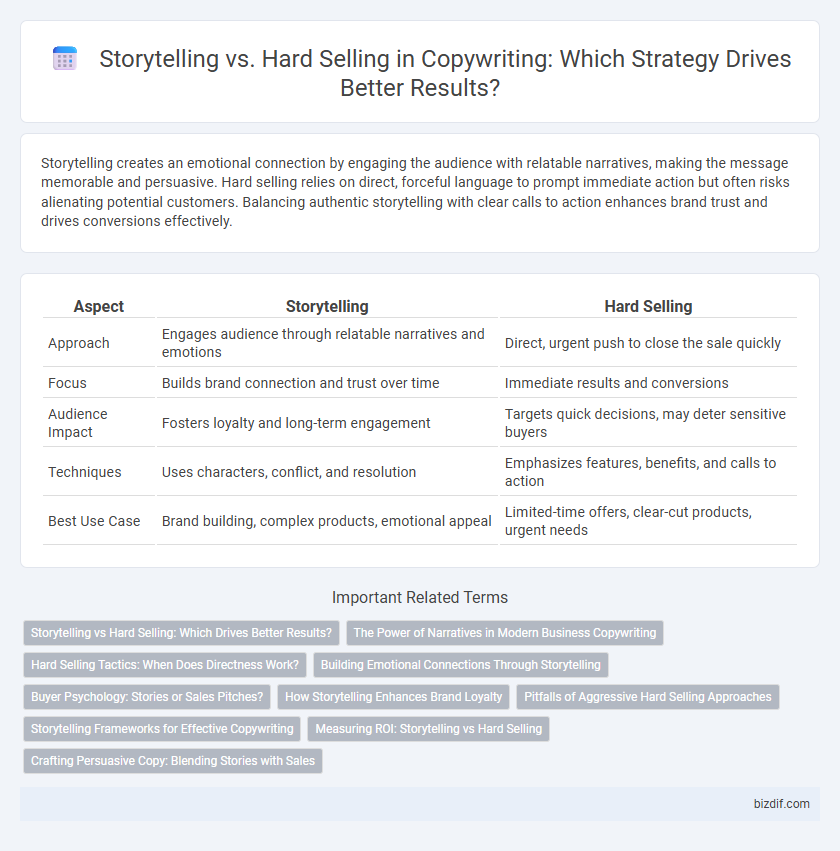Storytelling creates an emotional connection by engaging the audience with relatable narratives, making the message memorable and persuasive. Hard selling relies on direct, forceful language to prompt immediate action but often risks alienating potential customers. Balancing authentic storytelling with clear calls to action enhances brand trust and drives conversions effectively.
Table of Comparison
| Aspect | Storytelling | Hard Selling |
|---|---|---|
| Approach | Engages audience through relatable narratives and emotions | Direct, urgent push to close the sale quickly |
| Focus | Builds brand connection and trust over time | Immediate results and conversions |
| Audience Impact | Fosters loyalty and long-term engagement | Targets quick decisions, may deter sensitive buyers |
| Techniques | Uses characters, conflict, and resolution | Emphasizes features, benefits, and calls to action |
| Best Use Case | Brand building, complex products, emotional appeal | Limited-time offers, clear-cut products, urgent needs |
Storytelling vs Hard Selling: Which Drives Better Results?
Storytelling creates emotional connections by engaging audiences with relatable narratives, leading to higher brand loyalty and long-term customer retention. Hard selling relies on direct, persuasive tactics that may boost immediate sales but often results in lower customer trust and decreased repeat business. Marketing data shows that brands using storytelling see up to 55% higher customer engagement and conversion rates compared to those relying solely on hard selling techniques.
The Power of Narratives in Modern Business Copywriting
Storytelling in modern business copywriting leverages emotional connections and brand authenticity to engage audiences more effectively than traditional hard selling techniques. Narratives create memorable experiences that foster trust and customer loyalty, driving long-term conversions. Brands using storytelling see higher engagement rates and stronger brand recall compared to those relying solely on direct sales pitches.
Hard Selling Tactics: When Does Directness Work?
Hard selling tactics prove effective in high-pressure environments where immediate decisions are necessary, such as clearance sales or limited-time offers. Directness appeals to customers seeking clear, unambiguous information and quick value propositions, minimizing hesitation. Employing urgency, explicit calls to action, and straightforward benefits drives conversions by focusing on the product's practical advantages.
Building Emotional Connections Through Storytelling
Storytelling in copywriting creates emotional connections by engaging the audience with relatable narratives that resonate on a personal level. This approach fosters trust and brand loyalty, leading to higher conversion rates compared to hard selling tactics that rely on direct, aggressive promotion. Leveraging storytelling techniques such as vivid imagery and character-driven plots enhances message retention and strengthens customer relationships.
Buyer Psychology: Stories or Sales Pitches?
Storytelling engages buyer psychology by creating emotional connections and fostering trust, which enhances brand recall and encourages long-term loyalty. Hard selling triggers immediate decision-making through urgency and direct appeals, but often leads to buyer resistance or short-lived conversions. Understanding the buyer's mindset allows marketers to balance narratives that build rapport with persuasive calls-to-action for optimal conversion rates.
How Storytelling Enhances Brand Loyalty
Storytelling enhances brand loyalty by creating emotional connections that resonate deeply with consumers, making the brand memorable and relatable. Unlike hard selling, storytelling communicates values and experiences that foster trust and long-term engagement. Brands leveraging storytelling see increased customer retention and advocacy, driving sustainable growth.
Pitfalls of Aggressive Hard Selling Approaches
Aggressive hard selling often alienates potential customers by creating pressure and distrust, which can damage brand reputation. This approach neglects the emotional connection and engagement that storytelling fosters, leading to lower customer loyalty and reduced long-term sales. High-pressure tactics risk increased churn rates and negative word-of-mouth, undermining sustainable business growth.
Storytelling Frameworks for Effective Copywriting
Storytelling frameworks like the Hero's Journey and PAS (Problem-Agitate-Solution) enhance emotional engagement and brand relatability in copywriting, driving higher conversion rates. Incorporating narrative elements such as conflict, resolution, and character development helps create memorable content that resonates with target audiences. Effective storytellers use these frameworks to build trust, evoke empathy, and guide readers seamlessly toward a call-to-action.
Measuring ROI: Storytelling vs Hard Selling
Measuring ROI in copywriting reveals storytelling often drives higher engagement and long-term brand loyalty compared to hard selling, which typically generates immediate but short-lived sales spikes. Analytics tracking metrics such as customer lifetime value, conversion rates, and social media interaction demonstrate storytelling's superior ability to build emotional connections that translate into sustainable revenue growth. In contrast, hard selling's ROI is more readily quantified through direct response metrics and immediate sales performance, yet lacks the nuanced brand equity benefits fostered by narrative-driven campaigns.
Crafting Persuasive Copy: Blending Stories with Sales
Crafting persuasive copy requires blending storytelling techniques with hard selling strategies to engage and convert audiences effectively. Stories create emotional connections that build trust and resonate with readers, while clear sales messages drive urgency and prompt action. Combining narrative elements with strong calls to action enhances brand authenticity and maximizes conversion rates.
Storytelling vs Hard Selling Infographic

 bizdif.com
bizdif.com